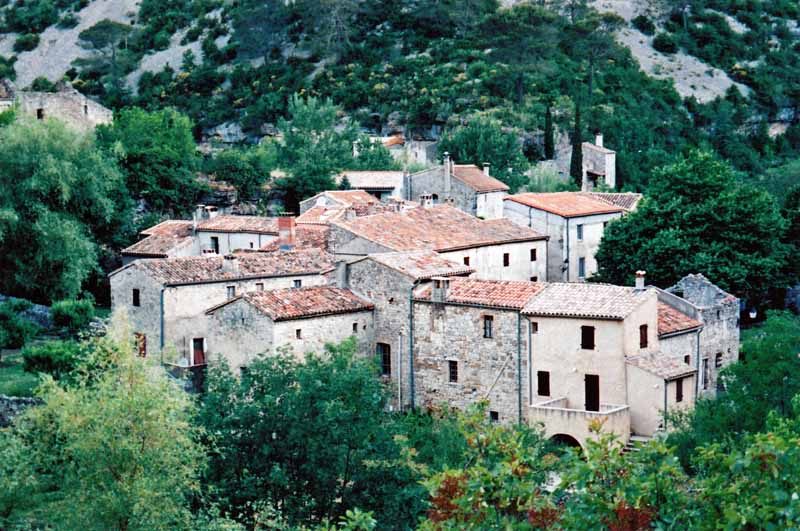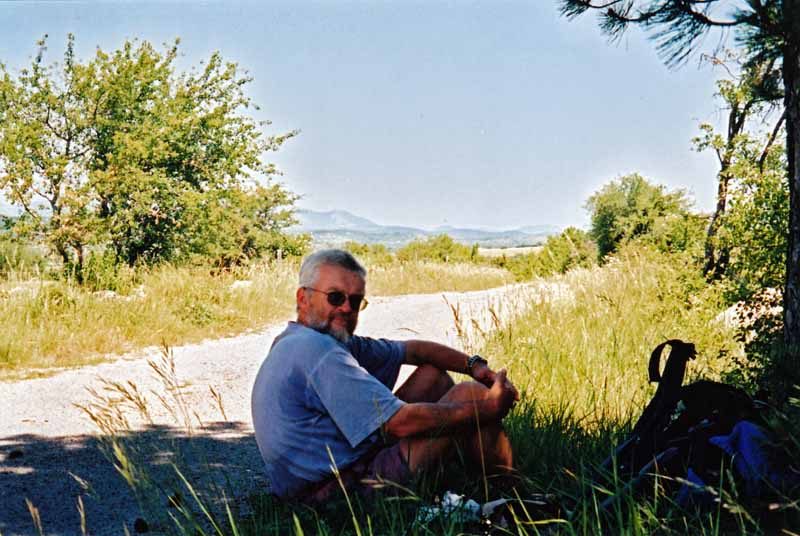Tuesday, 8 June 2004
Distance 20 km
Duration 5 hours 0 minutes
Ascent 527 m, descent 247 m
Map 65 of the TOP100 blue series (now superseded)
Topoguide (ref 716) Traversée du Haut-Languedoc – GR7, GR71

Leaving the cyclists comatose, we crept down the ladder-stairs to the kitchen, had a bite of muesli and packed up. Down another level and out into the quiet street, we set off to the cascade and began the long journey back to the causse, following the outward flow of the river.
The track rose above the houses and then levelled off, with the river far below wriggling like a cut snake, and the cliffs towering overhead.

At first it was alarmingly narrow and loose, high above the dark gorge, but then it descended to join a channel built into the precipitous hillside, taking water from Navacelles to a hydro-electric station further down at Madières. We walked on the little service road beside this channel for a couple of hours.
Eventually we reached the level of the river at a place with a ruined farmhouse, and the channel disappeared into the hillside.

We turned uphill on a rough switchback track towards a break in the cliffline, scrambling up a loose stony slope with groves of small, tough trees.
We had to make up all the height we had lost in the gorge and it was a great relief to pop out at last onto the plateau.
Not much further on we came to the village of Saint-Maurice, a single long street which did not look promising for walkers in need of a break.

Then we noticed the smallest bar in France, jammed between the road, a wall and a set of steps, with two little tables, an umbrella and some pots of roses under a handpainted sign.
A skinny cyclist was sitting on the steps drinking from a can. He ran an auberge in the high Pyrenees and was enjoying a few days of freedom before the tourist season.
We ordered coffee and got big breakfast bowls, with a jug of hot milk, as it was still technically morning, although the sun was hot and high. It was excellent coffee and we said so to the barwoman.

She told us that there was no food shop in town except a travelling one on Thursdays, but that she could sell us some things for lunch – a half-baguette, a tin of paté and some goat cheese.
She insisted on parcelling them up with a plastic bag of ice-blocks, bless her heart. Her good nature shone through the heavy mask of makeup that seems to be favoured by women in these parts.
Taking to the GR again, we followed quiet old roads marked with iron crosses until we saw a rare tree and stopped for lunch under its shade. The baguette had become soggy on one end through the kindness of the barwoman, so we left a bit of it on the wall for the ants and the birds.

Shortly we arrived at la Vacquerie, a tiny village backed up against a line of high ground. In the centre was a small square, with a war memorial surmounted by a lifelike crucifixion in white marble.
Looking onto it was a hotel, seemingly closed. As we knew there was no camping ground anywhere near, we hoped the hotel would take us in.
The door opened when we tried it, to reveal a dark bar in which a small girl and her parents were eating. Beyond, in the formal dining room looking out onto the back street, a quantity of people were hard at work on lunch, probably having driven a good distance for the pleasure.

I asked the dark, needle-faced woman about a room and she said the cheapest was €30, but we had seen €25 on the price list outside, a fact that she had to concede when she went to look. She quickly tore down the list, but we got the room for €25 and it was beautiful.
It was two floors up, with the ceiling and floor of dark boards and walls of white, all slightly crooked after a couple of centuries. A round window looked straight out onto the statue, whose whiteness we now saw was picked out, rather gruesomely, with dribbles of red at the wounds. Although we did not have a private bathroom, we had the whole floor to ourselves so it amounted to the same thing.
We showered, washed and slept, then went for a tour of the town, which took ten minutes. Then it was time for drinks at the bar and dinner. Our hostess had hesitated a fraction when I asked about dinner, and it turned out that we were the only people she cooked for, apart from her own family. They must make their money from lunches, if indeed they make any – we noticed the husband going off after lunch, presumably to a full-time job.
Under the glassy stare of a boar’s head, we sat down to eat. We began with a terrine and an excellent salad loaded with lardons and a poached egg. Then Keith had a steak the size of a bible and I chose boar, in honour of the head on the wall, but it was not the season for boar, so I settled for goat chops.
These must have been from a fearsome animal, as they dangled off both sides of the plate. The potatoes and all the vegetables were drowning in what the menu assured us was pure duck fat. Even I found it a bit rich, but it was compensated for by the freshness of the final course, white cheese with a chestnut sauce. Altogether, it was a fine meal for hungry walkers, and we had goat chops to spare for tomorrow’s lunch.
Previous day: Avèze to Navacelles